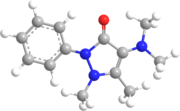This article needs additional citations for verification. (March 2020) |
 | |
 | |
| Clinical data | |
|---|---|
| AHFS/Drugs.com | International Drug Names |
| ATC code | |
| Pharmacokinetic data | |
| Metabolism | N-demethylation[1] |
| Identifiers | |
| |
| CAS Number | |
| PubChem CID | |
| DrugBank | |
| ChemSpider | |
| UNII | |
| KEGG | |
| ChEBI | |
| ChEMBL | |
| CompTox Dashboard (EPA) | |
| ECHA InfoCard | 100.000.332 |
| Chemical and physical data | |
| Formula | C13H17N3O |
| Molar mass | 231.299 g·mol−1 |
| 3D model (JSmol) | |
| |
| |
| (verify) | |
Aminophenazone (or aminopyrine, amidopyrine, Pyramidon) is a non-narcotic analgesic substance. It is a pyrazolone and a derivative of phenazone, which also has anti-inflammatory and antipyretic properties. While inexpensive and effective, especially in the treatment of rheumatism, the drug carries a serious risk of severe and sometimes fatal side-effects, including agranulocytosis.[citation needed] While its production and use have been banned in many countries, including France, Thailand, India and Japan, it is still sometimes used in the developing world.[citation needed]
A breath test with 13C-labeled aminopyrine has been used as a non-invasive measure of cytochrome P-450 metabolic activity in liver-function tests.[1] It is also used in measuring the total body water in the human body system.[2]
- ^ a b Caubet MS, Laplante A, Caillé J, Brazier JL (June 2002). "[13C]aminopyrine and [13C]caffeine breath test: influence of gender, cigarette smoking and oral contraceptives intake". Isotopes in Environmental and Health Studies. 38 (2): 71–7. Bibcode:2002IEHS...38...71C. doi:10.1080/10256010208033314. PMID 12219983. S2CID 22002940.
- ^ "Aminophenazone — Compound Summary". PubChem. The National Library of Medicine. 2005-03-26. Retrieved June 12, 2008.